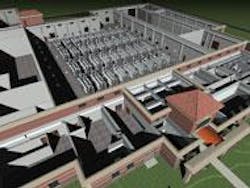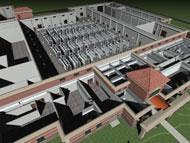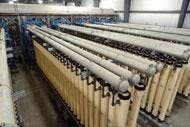Membrane Treatment Systems Gaining Acceptance in Drinking Water Industry
By Scott Freeman and Jonathan Pressdee
There is a quiet revolution changing the landscape of potable water treatment. For more than a century, the accepted filtration methods were based on granular media, such as sand or anthracite. However, in the last decade the number of large-scale — greater than 1 mgd — water treatment plants applying microfiltration (MF) or ultrafiltration (UF) membranes has increased rapidly, from one to almost 100 worldwide. MF/UF provides a physical barrier that effectively removes sub-micron particles, consistently producing a low-turbidity filtrate.
Concern over disinfectant-resistant pathogens, such as Cryptosporidium, has been a leading reason for the increased popularity of MF/UF membranes. Although such pathogens are not routinely present in source waters, treatment processes must be capable of removing or inactivating the microbes to protect consumers from gastrointestinal illnesses that are debilitating and sometimes fatal.
A membrane cartridge consists of thousands of spaghetti-sized hollow fibers, which are similar to miniature soaker hoses with sub-micron pores that block the impurities. The pathogens Giardia and Cryptosporidium are larger than 2 microns while the membrane pores are less than 0.5 micron. Based on the results of detailed empirical microbial challenge tests, California's Department of Health Services grants MF/UF equipment 4-log (99.99 percent) removal credit for Cryptosporidium and Giardia. In the United States, more than three-quarters of the states' regulatory agencies have accepted membrane filtration for municipal drinking water treatment.
When membranes were initially used to treat surface water in the mid-1990s, a simple membrane filtration approach with minimal pretreatment was generally applied. Pretreatment typically consisted solely of a protective backwashable screen with a rating in the 200- to 500-micron range to prevent comparatively large particles from plugging the membrane unit.
In many cases, however, simple membrane filtration is inadequate to fully meet the requirements of the Safe Drinking Water Act because many water supplies contain dissolved contaminants that exceed regulatory levels. Although they offer many benefits, MF/UF systems alone do not effectively control dissolved contaminants.
Treatment process designers today are likely to combine membranes with a variety of pretreatment technologies to address a broad range of water quality problems, including dissolved contaminants, color, taste and odor, and organics. In addition to expanding plant treatment capabilities, these pretreatment processes have been found to optimize membrane performance and reduce capital and whole-life costs.
The integration of MF/UF membranes with pretreatment to address multiple water quality issues and optimize membrane performance is site- and membrane-specific. Pretreatment options increasingly combined with membrane filtration to address a wider range of treatment problems include direct membrane filtration, in which coagulant is added and flocculated prior to membrane filtration; conventional clarification through coagulation-sedimentation, in which water is flocculated and then solids are settled out prior to filtration; alternative clarification, such as dissolved air flotation or ballasted flocculation, with membranes; and lime softening, in which lime is added and residuals are removed prior to filtration.
Examples of four projects in which Black & Veatch has integrated a variety of pretreatment and membrane processes are presented in the remainder of this article.
Scottsdale, AZ (Direct Membrane Filtration)
The 30-mgd Scottsdale Chaparral water treatment plant was designed to treat water from the Arizona Canal. The canal water is a blend of water from the Salt River, Verde River, and Central Arizona Project. Depending on the ratio of the blended waters, the dissolved arsenic concentration may exceed the regulatory limit of 10 mg/L. DBP-precursors and organic odor-causing compounds also need to be removed, and coagulants cannot sufficiently accomplish this.
To address the city's multiple water quality goals, the treatment process incorporates pretreatment coagulation, membrane filtration, and post-membrane granular activated carbon (GAC) contactors. The pretreatment step involves the addition of 10 to 15 mg/L of ferric coagulant, which was demonstrated in a pilot study to reduce a feed-water arsenic concentration of 15 mg/L to less than 1 mg/L in the finished water.
Membrane filtration was selected due to tight site constraints, higher water product quality, and its proven performance at the city's Scottsdale Water Campus, which commenced operations in 1999. A six-month membrane and GAC pilot study was conducted to establish design parameters and to pre-qualify acceptable membrane manufacturers for bidding, and a submerged UF filtration system was pre-purchased. Bids from general contractors are scheduled for October 2003, and construction should be substantially complete by late 2005.
Bakersfield, CA, (Coagulation-Sedimentation)
The new Bakersfield Water Treatment Plant, owned and operated by the California Water Service Co., is on the vanguard of the movement toward integrating membrane filtration with more conventional processes. The 20-mgd facility, which commenced operations in June 2003, has an ultimate build-out capacity of 60 mgd. A combination of ferric-based coagulation-flocculation-sedimentation with high-rate plate settlers plus membrane filtration provide a 1-2 punch to knock out dissolved contaminants and remove particulate material, turbidity, and cysts.
For this project the dissolved materials of concern were color, organics, and two chlorine-related disinfection byproducts (DBPs) – trihalomethanes (THMs) and haloacetic acids (HAAs). After evaluating various treatment options, the project team determined that the combination of plate settlers and MF/UF would be most cost-effective, yielding a construction cost savings of greater than 5 percent compared to membrane filtration without pretreatment.
The selected process is less expensive because the higher quality feed water allows higher flux operation with less frequent chemical cleanings; therefore, less membrane equipment was needed.
At capacity, the full-scale treatment consists of river water intake, 15 to 20 mg/L of coagulant addition, 15 minutes of flocculation time, plate settlers with an effective hydraulic loading rate of 0.4 gpm/sf, 11 parallel trains of Pall PVDF membranes at a flux of 57 to 65 gpd/sf, chlorine disinfection, and 3 million gallons of storage.
The membrane operating cycles are controlled based on flow totalizers that yield an air scrub-backwash cycle after every approximately 30 minutes of filtration time. Finished water turbidity is less than 0.03 NTU. TOC reduction across the plant is over 50 percent, from a concentration of 3.0 mg/L in the raw water to 1.4 mg/L in the finished water. Control of DBP formation has been effective, with finished water THMs consistently less than 40 ?g/L and HAAs less than 50 ?g/L.
South San Joaquin Irrigation District, CA, (Alternative Clarification)
On a case-by-case basis, alternative clarification methods, such as plate settlers, dissolved air flotation (DAF), and ballasted flocculation, may be more cost-effective than conventional sedimentation. A new 40-mgd UF membrane filtration plant was designed for the South San Joaquin Irrigation District and partner cities of Manteca, Lathrop, Escalon, and Tracy.
Due to the colloidal nature of the turbidity-causing suspended particles present in the source water — which resist settling without significant polymer addition — the project team evaluated dissolved air flotation (DAF) as well as conventional coagulation-sedimentation with a plate settler in a three-month pilot study.
The pilot study revealed that the application of DAF for pretreatment provided superior turbidity reduction, resulting in turbidity of 0.5 compared with 1.5 using conventional membrane pretreatment. In addition, UF performance was more stable with longer intervals between cleanings following DAF pretreatment. UF following DAF was selected for full-scale treatment.
Minneapolis, MN (Lime Softening)
The Minneapolis Water Works Columbia Heights membrane filtration plant is a 70-mgd UF facility that will treat lime-softened and clarified water from the Mississippi River when construction is completed in 2005. The process area will house 36 UF membrane units. Designers integrated the new membrane facility with existing coagulation-flocculation and settling systems, and the new pumping system, chemical dosing systems, and all ancillaries are housed in the same building.
After it was determined that the aging conventional filtration equipment had to be replaced or rebuilt, the utility conducted a detailed evaluation of options in a series of studies that involved health experts, citizen panels, and water treatment engineers. Options included rebuilding the granular media filters, adding ozonation, or replacing the granular media with UF membranes. A major factor that favored membranes was concern over the future possibility that disinfectant-resistant pathogens such as Cryptosporidium could occur in the upper Mississippi source water.
Pretreatment was studied in depth to ensure the optimum conditions were established for the membrane process because optimization of coagulation chemistry minimizes organic- and iron-fouling of the membranes and correct re-carbonation after softening minimizes carbonate scaling. No modifications to existing pretreatment were necessary, but the addition of membrane treatment will produce consistently high-quality drinking water even during spring runoff events.
About the Authors:
Scott Freeman is Senior Membrane Process Engineer at Black & Veatch and is based in the company's Kansas City, MO, office. Mr. Jonathan Pressdee is the Engineering Manager of the Black & Veatch Minneapolis, MN, office. Both are members of Proteus, the company's global team of water and wastewater treatment process specialists.


